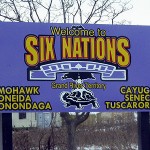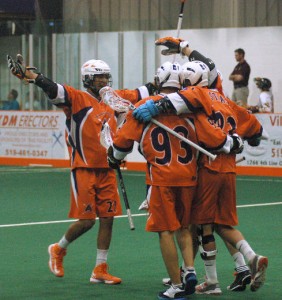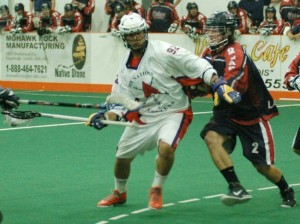My high school classmates from Six Nations called it “God’s country”, and it’s never been too hard to see why: a river, forests, dark night skies and pretty good farmland. It’s what remains of a huge grant of land along Ontario’s Grand River by the British crown to the Haudenosaunee, the league of the Iroquois. As part of my Canadian summer gotta-do list, I went to watch lacrosse with an old friend who loves this indigenous gift to the sporting world more and more, though he was mainly a hoopster when I first knew him. Here is an athletic

Actor Graham Greene joins Tom Longboat and E. Pauline Johnson among the best-known people from Six Nations — unless you know lacrosse.
context in which the Aboriginal community that I know best takes enormous pride, and a backseat to nobody. The Junior A loop in Ontario has become an Iroquois league of its own.
My hometown of Caledonia sits next to the reserve, and you may have heard that the relationship between the two communities has been a little rocky, suburban developers and Native land activists finding their paths and their words clashing. This isn’t about that; there’s more on the dispute here, if you like. Still, it’s been awhile since I was on Six Nations.
My little itch of anxiety wasn’t the reason I got lost – I’m a natural at that, and my head was spinning on its axis trying to see everything about the place – but my wandering contributed to my arrival at the Iroquois Lacrosse Arena (the ILA is on Second Line near Cayuga Road, homebodies) a little late. The first of three periods of “box lacrosse”, the indoor
game played in hockey rinks that has come to dominate the “field” version played internationally and in the NCAA, had already ended. The Six Nations’ perennially strong Junior A club, the Arrows, was in game three of a first-round playoff series with the Kitchener-Waterloo Braves. The Arrows aren’t all Aboriginal, but the majority are, and as I drove out on to the Reserve for the first time since the land dispute flared, it was hard not to think of it as another kind of white-native standoff. (These thoughts hang over my homeland like the pall from a crude oil fire. I find it hard to think of anything else when I’m in the south end of town.)
I went to the wrong end of the ILA, too, and was soon accosted by a gravelly voice among the escaped smokers. “You lost or somethin’, buddy?” I looked over, 98.7% sure it had nothing to do with being an unwelcome white guy. Sure enough, there was a grinning pair of broad-shouldered men I remembered from early in my teaching career, the Maracle twins, fine athletes from the “upper end” of the Rez whom I’d briefly tried to turn into high school basketball players. We shook hands, made introductions, and then they pointed me to the other end of the building, urging me to watch out for number 38, a latter-day Maracle.
Near the entrance was my friend the King, in his usual behind-the-net seats with his son and another lad. The between-periods show was a game with kids from the “paperweight” division, tiny little dudes in helmets and shorts playing cute-as-can-be lacrosse. Kinger quizzed me on family, but I was in the arena with that scent of sport, loved and excelled at, in the air. I tried to catch up with the game and the series to that point, and settled in to watch my first lacrosse in many a moon.
With so many Native kids in my area when I was growing up, lacrosse was a staple of high school Phys. Ed. classes, and a perfect occasion for the lads from Six Nations to laugh at us town kids. They could snake out their sticks for a twisting “Indian pickup” of rolling or bouncing balls that we had to club to a standstill, and then clumsily scoop into the leather webbing of our sticks. I even owned a stick for a while in grade 8 or 9, an embarrassingly excellent hand-made job my father bought for me from the famed Powless clan on Six Nations. This implement, a piece of art fashioned from wood and leather, was mainly used in solo efforts to bludgeon our house’s aluminum siding. I improved a little, but never actually played with anybody; besides, baseball and basketball were calling much more loudly. I played enough, though, to achieve a warm appreciation for the skills of anybody who can actually play that tough and subtle game. (It fits the wonderful phrase of Canadian poet Al Purdy, who called hockey “this combination of ballet and murder”.) For most boys on Six Nations, their casual control of stick and ball makes it feel like they’ve lobbed and caught, lobbed and caught and cradled that ball since they were toddlers. And they have.
How to describe lacrosse, if you don’t know the game? Hockey without skates? Not bad, since the indoor version has six players running and shooting and mugging one another inside the standard set-up of a rink, with artificial turf instead of ice. There is also the excitement of shift-changes during play, though lacrosse is a little slower (isn’t everything?) and a much more possession-oriented game than hockey is, and the massive goalkeepers are even more helpless than their icy counterparts. Basketball with sticks and body-checking? That’s quite apt, too, with lacrosse’s use of a 30-second shot-clock, and with the fast-breaks and some of the weaving and screening actions looking a lot like what I’d diagram as a hoops coach – well, yeah, aside from the guys getting cross-checked into the boards. It took me awhile to figure out what a player had to do to actually get a penalty, as ballhandlers are fiercely harassed and scoring attempts generally end up with the shooter being crunched and grounded.
The second intermission, and the post-game, showed me a taste of how a community like Six Nations, which has about 12,000 residents, can field and support so many competitive clubs and defeat much larger centres. As the Arrows and Braves filed off to their locker rooms, dozens of younger boys ran onto the floor with their weapons, firing balls off the plexiglass or the boards or into the nets. One boy, maybe 11 or 12, stood whipping that hard rubber off the glass not five feet from the home bench, where coaches still conferred. They didn’t flinch, nor did he, and their mutual confidence knocked me out. In many ways, this Reserve is a perfect storm of athletic development: heroes that are close to home, a deep and profoundly meaningful cultural link, a well-organized and well-supported program of development, and a clear tendency to let kids mess about and play. Youngsters on Six Nations grow up with more freedom than town kids do, especially in this over-organized era of fearful child-raising, and one of the ways it shows up is in the individual skills of the lacrosse players.
The Six Nations of the Iroquois have played great lacrosse for centuries. It’s a more prosperous place than when I was a kid, though, and these resources – to say nothing of the steady growth of the community’s pride, population and efforts for the preservation of culture – have only fed into this history of excellence. There is a dominating Junior B team, with two recent national championships, that feed up to the Arrows, along with two Senior teams that are in the mix for the Canadian amateur championship, the venerable Mann Cup, each summer. There are also two minor-pro teams that play at the ILA during the winter season, a step below the professional National Lacrosse League in cities in the northern U.S. and Canada. Familiar surnames from “God’s country”, Hills and Jamiesons and Bomberries and Powlesses, sprinkle NLL rosters in rather the same way shortstops seem to grow ready-made in the Dominican Republic. Six Nations is the kind of place that Daniel Coyle wrote about in The Talent Code, or Malcolm Gladwell in Outliers: it is a lacrosse hotbed that produces superb players in astounding numbers. It only makes sense when you see it.
The game ended 14-11 for the home and native side, a fairly typical boxla score. The Braves, clear underdogs to the top-seeded Arrows, eventually lost the series three games to one, though in the game I saw the homeboys seemed a bit fortunate to have a superior goaltender. Maybe, though, they’re just slicker, with more skilled finishers. Perhaps they were coasting a little, as highly ranked teams often do in the opening rounds of playoffs. Their captain, for instance, is a young man only four months removed from playing at the highest level of his sport.
The King had pointed out number 93 to me early on. He’s another of the storied Powless lacrosse men, his name is Johnny, and he plays this top-flight level of Junior lacrosse in the summer as an off-season breather from an already substantial professional career with the NLL champions, the Rochester (New York) Knighthawks. (This team is owned and managed by a Six Nations resident, and features several other down-home players as well.)
As I adjusted to the pace and strategies of the game, Captain Johnny drew my eyes more and more. He’s a deft and fluid scorer, though on this night I was most impressed by his vision and precise passing. Whenever he was on the floor, the Arrows were calm and in control, and some kind of clever delivery through a tiny defensive crack – often delivered with a casual backward flip of his stick – would make this point-guard-loving basketball coach grunt in appreciation. “JP 93”, they apparently like to call him, in this age where every sports star must have a hip-hop nickname and a catchy Twitter handle (though in this case, it does sound to me like a low-octane grade of gasoline, in the same way that basketball star Kevin Durant’s homey handle makes a Canadian think of Kraft Dinner, an instant mac’n’cheese dish that is a national treasure among young Canuck males). Johnny Powless isn’t an especially big or powerful player, but his finesse made him a calm technician among overeager boys. That was fun to watch.
The next morning, I ran back to Six Nations. The old boundary, the train tracks on Sixth Line, was an easy 15-minute jog on a hot July morning. I ran past the more recent territorial claims of some Six Nations residents and their supporters, though, only six or seven minutes from my brother’s house in town. Tempers have quieted but the tension remains. Despite this, and quite apart from watching some superb athletes in a game I now know a bit better, it was good to be on the reserve again. It was good to see those smiling twins, and to hear their shouts from the other end of the arena, even if number 38 wasn’t the player that I couldn’t stop watching. It was good to think of the Thomases, Logans, Martins, Staatses and Doxtdators with whom I went to school and played just about every game other than lacrosse.
Among the many other things that it is (including the largest Aboriginal community in Canada), Six Nations is lacrosse country. It’s a sport I admire, with a history that predates contact with Europeans. It has perhaps a more central place in culture than any other sport, and Native people like to call it the “Creator’s game”. No wonder my schoolmates called the Rez God’s country. This complicated, simply compelling patch of land and that furious, fast game were a lesson and a joy to visit. I’ll be back.




Fantastic article, J. I would encourage you to submit it to one of the Canadian Aboriginal national newspapers. Windspeaker in Edmonton is a good one or SAY magazine. When you say “I’ll be back” I know you sincerely have an interest in seeing more games and I hope in August during the later rounds of the playoffs we can catch another one. Rebels (Jr.B), Chiefs (Sr.A), Rivermen (Sr.B) and Arrows (Jr. A) all have legitimate chances of winning National Championships this season. Exciting times.